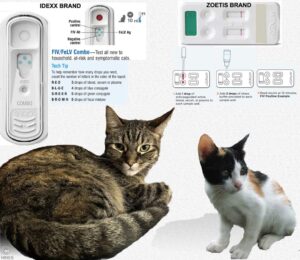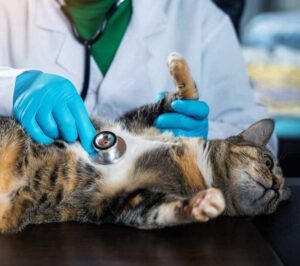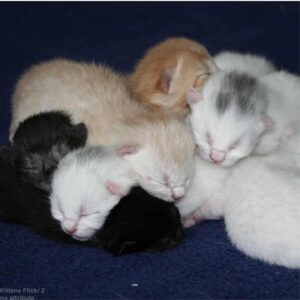Ron Hines DVM PhD

Less than one in ten cat pregnancies I see are planned events. What generally happens is that one of my clients becomes suspicious that a blessed event might be about to occur when their 6-9 month old cat is already 4–5 weeks pregnant and beginning to look a bit too plump in its tummy. Cats become fertile at a remarkably young age, and it is quite common for cat owners to put off spaying them for too long. You meant to, but other life events interfered.
Then there are the many unwanted and uncared for cats in this World, all desperate for homes but still producing kittens. That is why I try to talk all of my clients and readers out of breeding their cats or purchasing purebreds. To each his own, I understand that your situation and aspirations might be quite different from mine. If that is you, when you have thought things out and are fortunate enough to be able to plan ahead for the pregnancy, here are some suggestions that you can follow:






How Will I Know When My Cat is In Heat?
Most cats have a very distinctive, affectionate behavior when they are ready to breed. They typically roll around playfully on the floor and/or rub their posteriors against you and the furniture. They often become vocal and try to escape outside. They often stand arched, with their tail straight up and their back and rear legs stiffen whenever they are touched. Heat periods usually last 4 to 7 days. They tend to become longer and more frequent if your cat is not bred. An unsupervised female cat will mate several times during her heat cycle, so kittens in an unsupervised litter may have different fathers.
How Long Does A Normal Cat Pregnancy Last?
Gestation or the length of pregnancy in cats averages 64 days. It is most often between 62 and 67 days or about nine to ten weeks. When kitten litters are large, the length of pregnancy can be a day or two less. When litters are small, the length of the pregnancy might increase a bit.
What Should I Do When I Plan To Breed My Cat?
A Negative Feline Leukemia & Feline Immunodeficiency Test
Cats that are test-positive for either of these virus should never be bred. Some cats deal with these virus successfully for long periods of time. But pregnancy is a stressful even. It could easily lead to increased symptoms of either of these virus in the mother, as well as lead to miscarriages, and/or the production of weak kittens. Read more about these tests here.
Parasite Control
Your cats should always be parasite free. But that is particularly true of mother-to-be cats. Even when your female cat appears healthy to you, it can still harbor parasites that make their way into its kittens while they are still in its womb or shortly thereafter. The first is called transplacental or vertical transmission. (read here) In the second situation, parasite larva can also be present in the mother’s milk. Through that, they can transfer to her kittens. (read here) Some of the cats that have the potential to do this are negative on your vet’s fecal examination because the parasite larva are encysted (walled off) in a dormant state in the cat’s muscles. Those encysted larva have the potential to circulate again (reactivate) under the hormonal influence of pregnancy. That is particularly true in cats that live in catteries or in situations with many other cats are present. The degree of sanitation plays a large part in determining the likelihood of events like these occurring. Although tests such as Antech’s KeyScreen® GI Parasite PCR test, or Idexx’s Fecal Dx® antigen test are considerably more sensitive in detecting low numbers of parasites in your cat’s intestines than fecal flotation methods, I do not believe that either would be capable of detecting parasites in their tissue-encysted form.
Nevertheless, whenever possible, it is prudent to bring a sample of the mother-to-be’s stool to your local veterinarian’s office for a parasite ova check prior to breeding. I generally worm cats with oral pyrantel pamoate, and add praziquantel if required for tapeworms. Most vets use products that combine those two mild, or very similar drugs. There are incidences of various intestinal parasites, including hookworms, becoming resistant to those drugs. (read here) But that is more of a problem in dogs than it is in cats. Transmission factors such as dog racing, dog shows, doggy daycare and doggy parks are required to spread these genetic parasite resistance factors.
Eliminate all exposure to fleas in mother cats if you can. Keeping flea numbers under control is especially important once the kittens are born because kittens are highly susceptible to flea-bite anemia. In restricted nursery quarters, where warmth, humidity and bedding are common, fleas have the upper hand and reproduce rapidly. In those situations, fleas can cause serious anemia in kittens, stunting their growth and worse. Fleas also spread bartonella and certain tapeworms. Since many flea control products have label warnings about their use in pregnant animals, read their labels carefully. I would skip application of these products during pregnancy and resume them again once the kittens are 8 weeks old. Until then, just pick off any fleas you find with tweezers and drop them into a small cup of rubbing alcohol. Regarding the newer oral flea control products, At least one of them, Credelio®, states that “The safety of CREDELIO CAT has not been established in breeding, pregnant and lactating cats”. So those products need to be used before pregnancy begins and not again until the kittens are 8 weeks old.
The Importance of Good Nutrition During Pregnancy And Lactation
The nutritional needs of mother cats in late pregnancy and during nursing vastly increase. Nursing mothers with large litters require even more nutrients than their growing kittens. During their first six weeks of pregnancy, mother cats generally do not eat more than their usual pre-pregnancy amount. But starting at about their sixth week of pregnancy, your cat’s weight and appetite should begin to increase significantly. Start by offering about twenty-five percent more food than you used to. I often suggest switching the mother over to a diet designed for kittens and growing cats at that time. Balanced, home-cooked diets are also acceptable. But you must be absolutely certain that they contain adequate calcium to meet the needs of both the mother and the kittens. Powdered eggshell is a good source. I find the most acceptable natural sources of vitamin D3 and A to be cooked egg yolks and liver – fed in moderation. Because the kittens are pressing against her internal organs, the mother may not be able to eat as much at one sitting as she did before her pregnancy. Feed her several small meals a day instead of one or two large ones. Or better yet, keep her food available to her at all times in single-cat households. Be sure plenty of clean water is always available. On a premium commercial diet, there is no need to give a vitamin or mineral supplement. Vitamin supplements can actually do more harm than good. If your pregnant cat fails to gain weight, or even loses weight despite being offered additional dry food, see if some canned cat food might be preferred. If that does not reverse failure to gain weight, it’s time to consult your veterinarian. A few cats do over eat and become obese during pregnancy. If you fear that that is occurring, talk to your vet.
The time after kittens are born begins the most nutritionally challenging time in an adult cat’s life: Her food consumption should steadily increase over the 20 to 30 days following birth as her kittens grow and their demands for milk increases. By the time the first month is over, the mother should be eating two or four times the amount of food she ate before she became pregnant.
A Pregnancy Exam
For the first two or three weeks of pregnancy you probably won’t notice any changes in your cat, other than its lack of repeated heat cycles. Around the fifth week of pregnancy, the mother’s abdomen will begin to swell, and her nipples will enlarge. Queens with small litters might take longer to “show” than mothers with a larger litter. When the expectant mother is about thirty days pregnant, schedule an appointment with your veterinarian if the cat was not examined prior to becoming pregnant. This will be a “wellness” examination at which time your veterinarian will either manually palpate and confirm that kittens are present or visualize them through the use of an ultrasound apparatus. Ultrasound can often detect kittens as early as the 14-15th day of pregnancy. Ultrasound will detect fetal heartbeats after about day 24. By thirty days, your cat’s nipples should have begun to swell. Some veterinarians suggest an x-ray of the mother three weeks prior to delivery to count the number of kittens so you will know when labor is over and all the kittens are out. I do not feel that exposing a cat to radiation for this procedure is warranted. The only time it might be, would be if pelvic structure abnormalities were detected on examination (or a history of a prior auto accident/pelvic fracture). Then x-rays might confirm that the pelvic canal was still adequately wide for the babies to pass through on delivery. Today, Upsale is rampant. Resist attempts to sell you products and services without a complete explanation why they are needed. Don’t accept “it will be good for her”.
Exercise
Regular exercise and walks on a leash will help your cat keep her muscle tone and general health top-notch. Obesity is a potential danger in pregnant cats when delivery time comes. So try to control any tendency to plumpness with exercise and careful attention to her revised caloric needs in her early pregnancy when those extra calories are not needed. It is much safer to restrict diets before a cat becomes pregnant than after, but that is only an option in planned pregnancies. During the final three weeks of her pregnancy it is also often best to separate the mother-to-be cat from other cats in your household, as well as from cats from outside your family. Every group of cats has its own interpersonal dynamics.
Preparing For The Kittens
Prepare a room for the birth to occur. The room should have an impervious floor that makes your cleaning chores easy. It should not be drafty. It should be in a quiet area of your home. Prepare a bed for the cat, a laundry basket lined with towels or clean unscented clothing works well. Nothing kittens can get tangled in. Get her used to using it. If the mother is reluctant to stay in it, give her encouragement with petting and small food snacks. You can lead her to the designated whelping area when labor begins, but don’t expect her to stay there. She will almost certainly have her kittens outside of your chosen area. Let her do that uninterrupted. When she has completed her delivery, move her and them into the designated bed. Most cats don’t like to be bothered while they are delivering. There is no need for you to spend time comforting her. After the birth of the first few kittens, mothers are usually preoccupied with their babies and not upset at your presence. Give her the space she needs, but keep checking in on her regularly. It is quite possible that you will miss the birth process entirely. You could wake up one morning or return from work only to find you have a brand-new litter contentedly nursing on their mom. If your nursery room is not warm enough, you can make it warmer by wrapping a heating pad in a towel, set on “low,” and placing it under one quarter of the nursery bed. This allows the mother to move her kittens away from the heat source if she chooses to do so. If you wish, you can read some of my other articles on birthing and caring for newborn kittens here and here. Eminent labor often decreases a cat’s appetite.
By their third or fourth week, her kittens should have started to eat a bit on their own. Encourage that because it lowers the stress of milk production for their mother. By six to eight weeks, her babies should be fully weaned. At that time, her food consumption should revert back to the amount she ate prior to her pregnancy. Wean should be a gradual process. It helps the mother’s milk supply to dry up.
You are on the Vetspace animal health website
Visiting the products that you see displayed on this website help pay the cost of keeping these articles on the Internet













